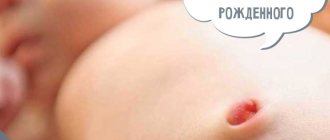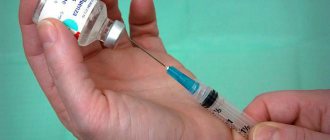The baby has just been making you happy with his smile, when suddenly he starts crying and the newborn’s lower lip is shaking? Do not panic, this condition is natural for a baby and is explained by the immaturity of its nervous and endocrine systems. In healthy children, the lower lip may twitch when crying, frightened, or abrupt awakening.
Trembling of the lower lip and chin in a newborn - normal or pathological?
In medical terminology, trembling of the lower lip and chin in a newborn as a result of involuntary muscle contraction is called tremor. Normally, this condition disappears within 3 months, in rare cases up to a year or a year and a half. The child may flinch when crying, waking up, or exposure to irritants from the external environment (light, sound, cold). Pathology is considered:
- the child’s lower lip trembles in a calm state;
- the baby’s lower lip and chin, limbs, and head are trembling;
- In infants, lip tremor occurs too often;
- the child has reached three months of age, and the trembling of the lower lip and chin when crying does not stop, but intensifies as he grows up. For premature infants, the pathology is tremor in children under one and a half years old and older;
- tremor of wide amplitude is a common symptom of neurological diseases.
Detection of at least one of the symptoms in a baby is a reason to contact a pediatric neurologist.
If tremor is accompanied by insomnia, upset bowel movements and abdominal pain, then contact an endocrinologist; most likely the problem is a malfunction of the thyroid gland. Uncontrollable muscle twitching in a baby is possible due to trauma (including birth).
Frequent trembling of the lower lip, chin and jaw, combined with regular regurgitation, anxiety, and insomnia, may indicate symptoms of muscular dystonia.
Pay attention to the baby's conditions in which the arms, legs or chin shake and try to avoid them. If this is not possible (for example, the lower lip begins to twitch when sucking), then at least try to create as calm an environment as possible.
- Why do ulcers appear on the lips and how to eliminate them quickly
- Red lips in a child: causes, treatment methods
- Furuncle on the lip in children and adults: causes, complications, how to treat
Complications and consequences of tremor
Physiological tremor does not pose any danger to the health of an infant. After 3-4 months after birth, trembling of the chin and lower lip disappears and no longer bothers either the child or his parents.
As for pathological tremor, here things are much more complicated. Prolonged and frequently recurring tremor is the first alarm bell indicating neuropathy. Involuntary contraction of the muscles of the chin, lips, upper and lower extremities, and head may indicate the presence of perinatal encephalopathy in the baby.
This pathology may include various disorders of the central nervous system that arise as a result of intrauterine development. If you consult a doctor in a timely manner, the disease can still be treated.
Advice!
If you identify one of the symptoms of pathological tremor, you should immediately contact a pediatric neurologist.
If the tremor of the lips and chin is not caused by neurology, then it is necessary to undergo a set of examinations to determine whether there is a deficiency of Ca and Mg in the baby’s body, and diabetes mellitus.
Possible causes of tremor
Why does a baby's lower lip shake? This condition is explained by the immaturity of his nervous and endocrine systems. Causes of normal tremor:
- When a baby is stressed, a significant amount of norepinephrine is released into the blood and the adrenal glands do not have time to control this process. Immature centers in the brain are not able to control the baby's movements.
- Tremors can occur in response to any stimulus (cold, hunger, music, bright light, stress).
- After sleep, the baby’s nervous system does not have time to switch to wakefulness mode; at this time, the baby’s lower lip can be observed trembling.
Why does pathological tremor occur? The main reasons are
- prematurity;
- the presence of intrauterine infections, birth injuries;
- pathologies during pregnancy and childbirth.
Hypoxia is a disturbance in the placental blood flow, this is associated with the development of the nervous system of the newborn baby. Risk factors also include polyhydramnios, intrauterine infections, placental abruption, weak labor or, conversely, rapid labor, entanglement in the umbilical cord, prolonged oxygen deprivation of the fetus, and the risk of miscarriage.
- regular stress of the mother (adrenaline produced in the mother’s body was passed on to the baby);
- mother’s abuse of bad habits and withdrawal syndrome (if the mother abruptly quit smoking or drinking alcohol);
- lack of calcium and magnesium;
- sepsis;
- increased intracranial pressure;
- damage to the peripheral nerves responsible for a specific muscle.
What parents can do
Parents can take a number of measures aimed at reducing the number of twitches and preventing their occurrence:
The most important condition for combating tremor is to create a comfortable environment and peace for the baby. All activities related to caring for a newborn baby (feeding, bathing, swaddling, walking, and so on) must be carried out measuredly, without unnecessary fuss, creating the most favorable and calm atmosphere for them.- A very good help in this event will be a relaxing massage, which, after a short course of training, parents can easily perform on their own at home.
- Herbs added to the bath (chamomile, lemon balm, oregano, valerian, mint, motherwort) perfectly relieve tension and relax the nervous system. But, given the risk of allergic reactions, using herbs more than three times a week is not recommended.
- For calm, measured functioning of the body, it is extremely important to follow a daily routine. In more severe cases, the pediatrician and neurologist may prescribe medications that improve oxygen supply to the brain (Mydocalm, Glycine).
In any case, you cannot do without visiting a neurologist, and it is especially important to get advice from a specialized doctor when the child is three, six and nine months old . During these periods, children experience the most intensive growth and development of the central and peripheral nervous systems, therefore, during these periods, the appearance of various neurotic pathologies is most likely.
In addition to the above periods, contacting a neurologist is also necessary in cases where certain symptoms occur:
- when the trembling does not go away after the child reaches six months of age; trembling of the chin and hands continuously lasts more than thirty seconds and occurs in a calm environment for no apparent reason;
- simultaneously with twitching of the arms and chin, a tremor of the head is observed, the trembling is characterized as large, literally “pounding”;
- during an attack, cyanosis (cyanosis) and perspiration appear on the baby’s skin;
- tremor appears continuously for several weeks in a row; pregnancy and childbirth occurred with a complicated history, which could lead to damage to the newborn’s brain as a result of oxygen starvation.
Having identified the pathologies that lead to twitching, the doctor prescribes treatment and, as a rule, the child’s condition quickly returns to normal, but only if all the prescriptions and recommendations of the specialist are strictly followed.
Tokareva Larisa, pediatrician
17, total, today
( 177 votes, average: 4.53 out of 5)
Can a baby have milk?
Sleep of a newborn baby and a child of the first year of life: sleep and wakefulness
Related Posts
What to do if your child’s lower lip shakes when crying
To reduce tremors, take the following measures:
- Create a calm environment at home, surround your baby with affection and care. Calm down yourself, the mother’s emotional state is transmitted to the child.
- Remove irritants from your baby's room (for example, too bright lights, loud TV, heavy music). Scientists say that kids love classical and instrumental music and the sounds of nature.
- Bathe your baby in herbal decoctions (chamomile, lemon balm, string). First make sure that the baby is not allergic to them.
- Breastfeed as long as possible, this affects the development of nervous tissue.
- Establish a rational sleep and rest schedule for the baby. It is better to fall asleep and wake up at approximately the same time, and it is also better to eat at the same time.
- Walking in the fresh air promotes oxygen saturation. Dress appropriately for the weather and prevent your baby from overheating.
- Toughen up your child. For a baby, the best option is wiping with a towel.
- If a child’s lower lip trembles, a neurologist will prescribe a massage. There are no contraindications for it; it is recommended for healthy children. Massage can be performed either by a medical specialist or independently. Before the procedure, ensure the required air temperature in the room and turn on calm music. Prepare a changing table or other flat and hard surface, lay down a mattress or diaper. Don't forget to cut your nails to avoid hurting your baby.
Remember that your baby's skin is very delicate and should not be rubbed. Do all exercises carefully, do not unnecessarily tug or shake the baby.
The main movements present in massage are vibration, stroking and rubbing. The optimal time for the procedure is 5-10 minutes.
Here is an example of some manipulations during massage
- Start the massage by stroking the arms and legs.
- Massage each finger on your hand.
- Massage your back and chest in a herringbone pattern (up, down and sideways movements).
- Massage of the tummy is carried out from the pubis in a clockwise direction (similar to massage for colic).
- We massage the legs from the toes to the hip joint.
- Finish the procedure by stroking your face and cheeks.
It is not recommended to touch the area of the liver and spinal column. Massage can be replaced or supplemented with the following gymnastic exercises
Lying on your back
- crossing and spreading the right and left arms;
- raising your arms parallel to your body;
- exercise “bicycle” for legs;
- pulling the legs towards the tummy;
Pronation
- clasp your hand around the baby's foot and lightly tap it ("hammer" exercise);
- The “chickens” exercise involves alternating stroking and pinching the baby’s back. Afterwards, you can take the baby under the armpits to imitate walking. Exercises on a fitball have a good effect.
How to prevent lip tremors in a baby
Tremor prevention measures are aimed at maintaining a stress-free pregnancy and caring for the unborn baby.
- During pregnancy, a woman must understand that she is responsible not only for her own life, but also for the life of her baby. Planning a pregnancy also means giving up bad habits in advance. Be calm, live in harmony with the world around you, find the strength to avoid stress, and periodically listen to calm music.
- If you are sick with chronic or infectious diseases, then they should be cured, because everything is transmitted to the fetus at birth through the placenta.
- Visit your doctor regularly and follow all his instructions.
Fortunately, tremor in an infant is rarely a symptom of severe neurological diseases. And it occurs only in 50% of babies. If you follow your doctor's recommendations during pregnancy, you can avoid the appearance of tremors.
The article has been verified by the editors









